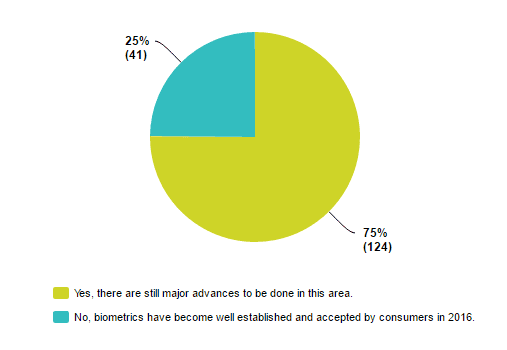In December we polled 165 professionals in biometrics and identity related industries about various topics from the past year. It was part of the FindBiometrics Year in Review, the longest-running and best regarded industry retrospective of its kind. Now in its 14th consecutive year, the FindBiometrics Year in Review is your resource to start 2017 off with your fingers on the pulse of biometrics and global identity management.

So far we have examined our respondents’ answers regarding the most exciting modalities of last year and the various factors that led 2016 to being voted the year biometrics technology truly felt mainstream. Today we will follow up with an interesting result considering what we’ve already examined. We asked our survey respondents:
In your opinion, are consumer biometrics still in a nascent phase?
Here is what they had to say:

The overwhelming majority agree that consumer biometrics are still in a nascent phase, with only 25 percent of survey respondents believing biometrics have become well established and accepted by consumers. While at a glance this seems to conflict with previously released results—that the majority of our survey sample think biometrics felt mainstream last year—it actually highlights an important topic that has emerged from the growing popularity of consumer biometrics.
You’re Only As Secure As Your Weakest Lock
For years the mantra of biometric adoption has been “convenience and security.” That, after all, is the promise of a biometric solution. A fingerprint or iris scan is superior to a password because it’s easier to authenticate with, but also because it is the more secure factor by nature. Unlike a password or PIN (something you know), a biometric (something you are) can’t be guessed or shared, and takes an incredible amount of effort to steal by comparison. Unfortunately, in the consumer world, biometrics still leave much to be desired in the consumer space, specifically in the category of security.
The current state of consumer grade biometrics is one that favors convenience above all else, and that is likely a factor in how popular the technology has become in recent years. When it comes to securing a consumer device—be it a smartphone, tablet, or PC with Windows 10—biometric solutions can generally be circumvented by a password, PIN, or gesture. And if a user can opt out of submitting a biometric to unlock a device, then the biometric is not providing any security beyond what’s already offered by old authentication means. It’s a cool feature that makes life easier, but a hacker isn’t going to try to spoof your fingerprint sensor if all they have to do is crack your code.
Last year was remarkable for the proliferation of biometrics on consumer electronics, and judging by last week’s CES in Las Vegas as well as the latest market research, 2017 will continue the trend. Biometric technology is more accessible to the everyday user than it ever has been before, and it is making login procedures more convenient while demystifying a new security concept to the public. But as a security measure, consumer biometrics will be stuck in the shadow of their true potential until we are given the option to nix PINs and passwords as fail-safe measures and be fully assured when authenticating with who we are.
*
Stay posted to FindBiometrics throughout January as we continue to breakdown our Year in Review 2016 results.
The FindBiometrics Year in Review is presented in association with SIA and made possible by our sponsor: Tascent



Follow Us